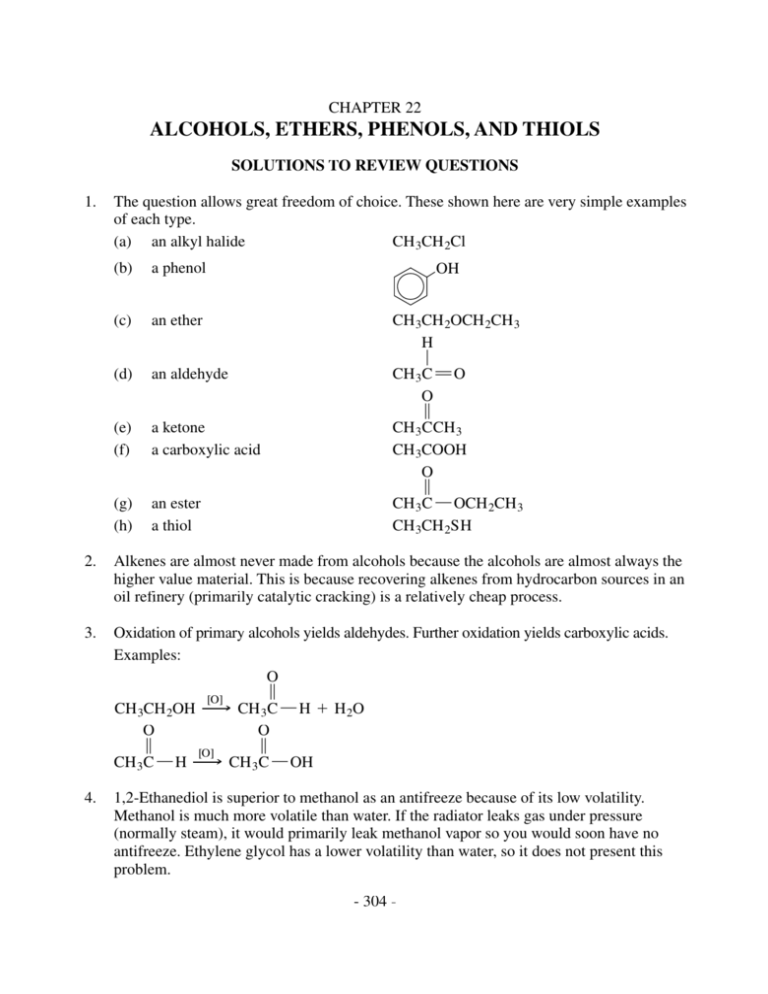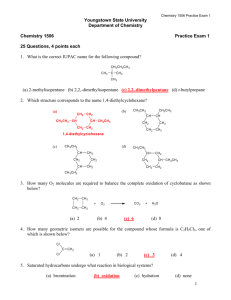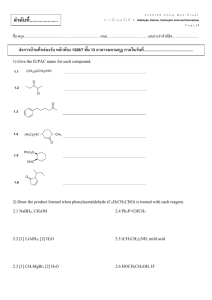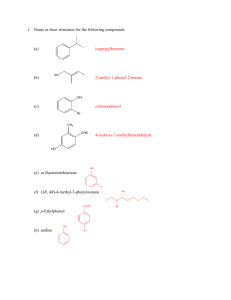ALCOHOLS, ETHERS, PHENOLS, AND THIOLS
advertisement

CHAPTER 22 ALCOHOLS, ETHERS, PHENOLS, AND THIOLS SOLUTIONS TO REVIEW QUESTIONS 1. The question allows great freedom of choice. These shown here are very simple examples of each type. (a) an alkyl k halide CH 3CH 2Cl (b) a phenol (c) an ether ( d) an aldehyde (e) (f) a ketone a carboxylic acid (g) (h) an ester a thiol OH CH 3CH 2OCH 2CH 3 H ƒ CH 3C “ O O ‘ CH 3CCH 3 CH 3COOH O ‘ CH 3C ¬ OCH 2CH 3 CH 3CH 2SH 2. Alkenes are almost never made from alcohols because the alcohols are almost always the higher value material. This is because recovering alkenes from hydrocarbon sources in an oil refinery f (primarily catalytic cracking) is a relatively cheap process. 3. Oxidation of pri r mar ary alcohols yields aldehydes. Furt rther oxidat a ion yields car arboxylic acids. Examples: O ‘ [O] " CH 3CH 2OH C H 3 C ¬ H + H 2O O O ‘ ‘ [O] " CH 3C ¬ OH CH 3 C ¬ H 4. 1,2-Ethanediol is superior to methanol as an antifreeze because of its low volatility. Methanol is much more volatile than water. If the radiator leaks gas under pressure (normally steam), it would primarily leak methanol vapor so you would soon have no antifreeze. Ethylene glycol has a lower volatility than water, so it does not present this problem. - 304 - - Chapter 22 - 5. Oxidation of alcohols affects f the hydroxyl carbon in two ways: (1) the carbon adds a new bond to oxygen; (2) the carbon loses a bond to hydrogen. When the hydroxyl carbon is not directly bonded to hydrogen (as in tertiary alcohols), oxidation is diff fficult. 6. Menthol affects f neurons that sense temperature. Binding of this alcohol to a neuron adjusts the neuron’s temperature sensitivity. The neuron then signals “pleasantly cool” even though the temperature is actually warm. 7. The liver oxidizes ingested meth t anol, fi f rst to meth t anal (fo f rmaldehyde) and th t en to meth t anoic acid (fo f rmic acid). Meth t anoic acid is much more toxic th t an meth t anol. This acid causes metab a olic acidosis and inhibition of centr t al energ r y metab a olism th t at can lead to death t . 8. The following classes of organic compounds can be easily formed from alcohols: aldehydes, ketones, and carboxylic acids by oxidation; alkenes and ethers by dehydration; esters by esterifi f cation. 9. ± benzene O2 CH3CH “ CH2 H2SO4 propene CH3 ƒ ¬ C¬ O ¬ O ¬ H ƒ CH3 dilute H2SO4 cumene hydroperoxide CH3 ƒ ¬ CH ƒ CH3 cumene (isopropylbenzene) OH ± phenol CH3CCH3 ‘ O acetone 10. Some common phenols include (a) hydroquinone, a photographic reducer and developer, f vanillin, (d) thymol, used as an (b) vanillin, a flavoring, (c) eugenol, used to make artificial antiseptic in mouthwashes, (e) butylated hydroxytoluene (BHT) an antioxidant and, (f) the cresols, used as disinfectants. 11. Low molar mass ethers present two hazards. They are very volatile and their highly flammable vapors form explosive mixtures with air. They also slowly react with oxygen in the air to form unstable explosive peroxides. 12. Ethanol (m olar f nt ar m ass a = 46.07) is a liquid at room temperature because it has a significa amount of hydrogen bonding between molecules in the liquid state, and thus has a much higher boiling point than would be predicted from molar mass alone. Dimethyl ether (m olar ar m ass a = 46.07) is not capable of hydrogen bonding to itself, so has low attraction between molecules, making it a gas at room temperature. - 305 - - Chapter 22 - SOLUTIONS TO EXERCISES OH 1. (a) CH3 CH3 CH3CHCH3 (d) CH3CHCH 2C CH3 OH CH2 OH ( b) CH (e) OH OH CH2 OH CH3 (c) CH3 CH3 CH2 CH CH2 CHCH2 OH (f) CH3CH2OH OH 2. (a) OH (d) CH2 OH OH (b) CH3 CCH2 CH3 (e) CH3 CH3 C CH OH CH2 OH OH CH3 OH (c) CH3 CHCH2 CH2 OH CHCH2 CH2 CH3 (f) CH3 CH3 C CH3 CCH2 CH3 CH3 CH3 - 306 - 3. There are only ffive isomers: CH3 CH3CCH2 CH2OH CH3 CH3 HO CH3 CH3 CH3 CHCCH3 CH3CH2CCH2 OH CH3 CH There are only eight isomers: CH3 CH3 CH3 HO CH2CHCH 2CH2CH3 CH3CCH2 CH2 CH3 CH3 OH CH3 CHCH2 CHCH3 CH3 CH3CH CH CH2CH3 OH CH3CHCHCH2CH3 OH OH 5. OH CH3C HCHCH2OH CH3 CHCCH3 CH3 4. H3 C CH3 CH3 CH3 CH3CH CH 2CH2CH2OH HOCH2CH2CHCH2CH3 CH3 CH3CH2 CCH2CH3 OH (a) primary alcohols (where the hydroxyl carbon is bonded to one other carbon): c, f; (b) secondary alcohols (where the hydroxyl carbon is bonded to two other carbons): a, e; (c) tertiary alcohols (where the hydroxyl carbon is bonded to three other carbons): d; diol (where the compound contains two hydroxyl groups): none; triols (where the compound contains three hydroxyl groups): b. - 307 - - Chapter 22 - 6. (a) primary alcohols (where the hydroxyl carbon is bonded to one other carbon): none; (b) secondary alcohols (where the hydroxyl carbon is bonded to two other carbons): a, c, d; (c) tertiary alcohols (where the hydroxyl carbon is bonded to three other carbons): b, f; diol (where the compound contains two hydroxyl groups): none; triols (where the compound contains three hydroxyl groups): e. 7. The names of the compounds are: (a) 1-butanol (butyl alcohol) (b) 2-propanol (isopropyl alcohol) (c) 2-methyl-3-phenyl-l-propanol (d) oxirane (ethylene oxide) (e) (f) (g) 2-methyl-2-butanol 2-methylcyclohexanol 2,3-dimethyl-1,4-butanediol The names of the compounds are (a) ethanol (ethyl alcohol) (b) 2-phenylethanol (c) 3-methyl-3-pentanol (d) 1-methylcyclopentanol (e) (f) (g) 3-pentanol 1,2-propanediol 4-ethyl-2-hexanol 8. 9. 10. Chief product of dehydration CH 3 ƒ (a) CH 3C “ CHCH 3 (b) CH 3CH “ CHCH 2CH 3 2-methyl-2-butene 2-pentene (c) cyclohexene Chief product of dehydration CH3 (a) 1-methylcyclopentene (b) (c) CH 3CH “ CHCH 3 CH 3 ƒ CH 3C “ CHCH 2CH 3 2-butene 2-methyl-2-pentene - 308 - - Chapter 22 - OH 11. (a) (c) OH CH3 cyclopentanol (b) CH3 CH2 1-methylcyclohexanol CH2OH CH CH3 2-methyl-1-butanol OH CH3 12. OH (a) (c) CH3 CH3 CH2CHCH2 CH3 3-pentanol 1,2-dimethylcyclohexanol CH 3 (b) HOCH2CH 2CH 2 C CH 3 CH 3 4,4-dimethy1-1pentanol 13. Primary alcohols oxidize to carboxylic acids; secondary alcohols oxidize to ketones; tertiary alcohols don’t easily oxidize. O (a) CH3CCH2CH3 ( b) HOOCCH2CHCH2CH3 butanone 3-ethylpentanoic acid CH2CH3 - 309 - - Chapter 22 - O 14. (c) CH3CCH3 ( d) NR acetone, propanone Primary alcohols oxidize to carboxylic acids; secondary alcohols oxidize to ketones; tertiary alcohols don’t easily oxidize. (a) HCOOH, methanoic acid, formic acid. (b) NR (c) CH3COOH, ethanoic acid, acetic acid O (d) 15. CH 3 CH 2 CCH 2 CH 2 CH 3 3-hexanone k group and oxygen bonded to Upon ester hydrolysis, the alcohol forms from the alkyl the C=O. (a) HOCH2CH2CH2CH3 (b) HOCH2CH3 1-butanol ethanol OH (c) 16. 2-propanol CH3 CHCH3 Upon ester hydrolysis, the alcohol forms from the alkyl k group and oxygen bonded to the C=O. OH (a) cyclopentanol CH 3 17. ( b) HO CH 2 CH CH 3 2-methyl-1-propanol (c) CH3OH (a) CH3CHBr CH3 (b) Br methanol 2-bromopropane bromocyclohexane (cyclohexyl bromide) - 310 - - Chapter 22 - (c) 18. (a) ( b) (c) 19. CH 3 ƒ CH 3CHCH 2CH 2Br 1-bromo-3-methylbutane CH 3CHCH 2CH 3 ƒ OH CH 2CH 3 ƒ CH 3CHCHCH 2CH 3 ƒ OH 2-butanol 3-ethyl-2-pentanol ¬ OH cyclopentanol 140°C " (a) O4 2 CH 3CH 2OH + H 2SO CH 3CH 2OCH 2CH 3 + H 2O diethyl ether (b) CH 3CH 2CH 2OH + H 2SO O4 (c) O ‘ K2Cr2O7 CH 3CH(OH)CH 2CH 3 99 : H C C 3 CH 2CH 3 + H 2O H SO O 180°C " 2 CH 3CH “ CH 2 + H 2O propene 4 2-butanone ( d) O ‘ H+ CH 3CH 2C ¬ OCH 2CH 3 99: CH CH 2COOH + CH 3CH 2OH H O 2 3 propanoic acid 20. (a) 2 CH 3CH 2OH + 2 Na ¡ 2 CH 3CH 2O -N a+ + H 2 (b) O ‘ K2Cr2O7 CH 3CH 2CH 2CH 2OH 99 : H H C C C H C 3 2 2 OH H SO O 2 (c) (d) ¬ CH “ CH2 ethanol 4 H 2O ¬ CHCH3 ƒ OH H2SO4 O O ‘ ‘ CH 3CH 2C ¬ OCH 3 + NaO a H ¡ CH 3CH 2C ¬ O -Naa+ + CH 3OH - 311 - - Chapter 22 - 21. (a) (b) (c) 2-methyl-l-propanol OH ƒ CH 2 ¬ CH ¬ CH 3 ƒ CH 3 3-methyl-2-butanol OH ƒ CH 3 ¬ CH ¬ CH ¬ CH 3 ƒ CH 3 cyclopentanol ¬ OH 22. (a) (b) (c) Methanol, CH 3 ¬ OH CH 3 ƒ 2,2-dimethyl-l-propanol CH 3 ¬ C ¬ CH 2 ¬ OH ƒ CH 3 CH 3 ƒ 3,3-dimethyl-1-pentanol CH 3 ¬ CH 2 ¬ C ¬ CH 2CH 2 ¬ OH ƒ CH 3 23. (a) (b) (c) methanol 2-methyl- l-propanol cyclohexanol 24. (a) (b) (c) cyclopentanol 2-propanol 2-methyl-2-propanol 25. (a) o-methylphenol (b) m-dihydroxybenzene OH OH CH3 OH - 312 - - Chapter 22 - (c) 4-hydroxy-3-methoxybenzaldehyde H¬C“O OCH3 OH 26. (a) p-nitrophenol (b) 2,6-dimethylphenol OH OH H3C CH3 NO2 (c) o-dihydroxybenzene OH OH 27. (a) (b) phenol m-methylphenol (c) (d) 28. (a) (b) p-dihydroxybenzene (hydroquinone) (c) 2,4-dimethylphenol (d) 29. Order of increasing solubility in water [c (lowest), a, b, d (highest)] (c) CH 3CH 2CH 2CH 2CH 3 (1) (b) CH 3CH(OH)CH 2CH 2CH 3 (3) (a) CH 3CH 2OCH 2CH 2CH 3 (2) (d) CH 3CH(OH)CH(OH)CH 2CH 3 (4) 30. Order of decreasing solubility in water: [a (highest), d, c, b (lowest)] (a) CH 3CH(OH)CH(OH)CH 2OH (1) (c) CH 3CH 2CH 2CH 2OH (3) (d) CH 3CH(OH)CH 2CH 2OH (2) (b) CH 3CH 2OCH 2CH 3 (4) 31. The three compounds have about the same molar mass but differ f with respect to hydrogen bonding and polarity. Compound (b) (1-propanethiol) does not hydrogen bond, is nonpolar, and so, has the lowest boiling point. Compound (c) (diethyl ether) is polar but does not hydrogen bond to itself. It has a higher boiling point than compound (b). Compound a (1,2-propanediol) hydrogen bonds to itself and has the highest boiling point. - 313 - 2-ethyl-5-nitrophenol 4-bromo-2-chlorophenol 2,4-dinitrophenol m-hexylphenol - Chapter 22 - 32. The three compounds hav a e about the same molar mass but differ f with respect to hydrogen bonding and polarity. Compound (c) (pentane) does not hydrogen bond, is nonpolar, and so, has the lowest boiling point. Compound (b) (diethyl ether) is polar but does not hydrogen bond to itself. It has a higher boiling point than Compound (c). Compound (a) (2-butanol) hydrogen bonds to itself and has the highest boiling point. 33. (a) ( b) (c) common, isopropyl methyl ether; IUPA P C, 2-methoxypropane common, ethyl phenyl ether; IUPA P C, ethoxybenzene common, butyl ethyl ether; IUPA P C, 1-ethoxybutane 34. (a) (b) (c) common, ethyl methyl ether; IUPA P C, methoxyethane common, ethyl isobutyl ether; IUPA P C, 1-ethoxy-2-methylpropane common, ethyl phenyl ether; IUPA P C, ethoxybenzene 35. Fourteen isomeric ethers; C6H 14O CH 3OCH 2CH 2CH 2CH 2CH 3 methyl-n-pentyl ether (1-methoxypentane) CH 3 ƒ CH 3OCHCH 2CH 2CH 3 2-methoxypentane CH 2CH 3 ƒ CH 3OCHCH 2CH 3 3-methoxypentane CH 3 ƒ CH 3OCH 2CHCH 2CH 3 1-methoxy-2-methylbutane CH 3 ƒ CH 3OCH 2CH 2CHCH 3 1-methoxy-3-methylbutane CH 3 CH 3 ƒ ƒ CH 3OCH ¬ CHCH 3 2-methoxy-3-methylbutane CH 3 ƒ CH 3OCH 2C ¬ CH 3 ƒ CH 3 1-methoxy-2,2-dimethylpropane CH 3CH 2OCH 2CH 2CH 2CH 3 n-butyl ethyl ether (1-ethoxybutane) CH 3 ƒ CH 3CH 2OCHCH 2CH 3 sec-butyl ethyl ether (2-ethoxybutane) CH 3 ƒ CH 3CH 2OCH 2CHCH 3 ethyl isobutyl ether (1-ethoxy-2-methylpropane) - 314 - - Chapter 22 - 35. 36. (cont). CH 3 ƒ CH 3CH 2OC ¬ CH 3 ƒ CH 3 t-butyl ethyl ether (2-ethoxy-2-methylpropane) CH 3CH 2CH 2OCH 2CH 2CH 3 di-n-propyl ether (1-propoxypropane) CH 3 ƒ CH 3CH 2CH 2OCHCH 3 isopropyl-n-propyl ether CH 3 CH 3 ƒ ƒ CH 3CHOCHCH 3 diisopropyl ether Six isomeric ethers: C5H 12O CH 3 ƒ CH 3OCHCH 2CH 3 sec-butyl methyl ether (2-methoxybutane) CH 3OCH 2CH 2CH 2CH 3 n-butyl methyl ether (1-methoxybutane) CH 3 ƒ CH 3OCCH 3 ƒ CH 3 t-butyl methyl ether (2-methoxy-2-methylpropane) CH 3 ƒ CH 3OCH 2CHCH 3 isobutyl methyl ether (1-methoxy-2-methylpropane) CH 3 ƒ CH 2CH 2OCHCH 3 ethyl isopropyl ether (2-ethoxypropane) CH 3CH 2OCH 2CH 2CH 3 ethyl n-propyl ether (1-ethoxypropane) 37. Possible combinations of reactants to make the following ethers by the Williamson W synthesis: CH 3ONa + CH 3CH 2Cl or (a) CH 3CH 2OCH 3 CH 3CH 2ONa + CH 3Cl - 315 - - Chapter 22 - (b) CH2OCH2CH3 CH2ONa CH2Cl or (c) 38. O ¬ CH2CH3 ± CH3CH2Cl ± CH3CH2ONa ONa ± CH3CH2Cl Possible combinations of reactants to make the following ethers by the Williamson W synthesis: CH 3CH 2CH 2ON a + CH 3CH 2CH 2Cl (a) CH 3CH 2CH 2OCH 2CH 2CH 3 CH 3 CH 3 ƒ ƒ HCONa + CH 3CH 2CH 2Cl (b) HCOCH 2CH 2CH 3 ƒ ƒ CH 3 CH 3 (c) O cannot be made by the W Williamson synthesis. Cannot use secondary RX. 39. IUPA P C names (a) 2-methyl-2-butanethiol (b) cyclohexanethiol (c) 2-methyl-2-propanethiol (d) 2-methyl-3-pentanethiol 40. IUPA P C names (a) 2-methylcyclopentanethiol (b) 2,3-dimethyl-2-pentanethiol (c) 2-propanethiol (d) 3-ethyl-2,2,4-trimethyl-3-pentanethiol 41. (a) (b) 3CHCH 3 ƒ SH CH3CH2 CHCH2CH2CH2SH CH CH3 CH3 - 316 - (c) SH CH3 42. (a) SH CH2CH3 43. ( b) CH 3CH 2CHCH 2CH 3 ƒ SH (c) CH 3 ƒ CH 3CH 2CCH 2SH ƒ CH 3 OH 4-hexylresorcinol or 4-hexyl-1,3-dihydroxybenzene OH CH2(CH2)4CH3 44. OH OH OH cis-1,2-cyclopentanediol 45. OH trans-1,2-cyclopentanediol The phenol compound (3-methylphenol) is more acidic than the alcohol compound (benzyl alcohol) but is less acidic than carbonic acid. - 317 - - Chapter 22 - 46. The name “catecholamine” is built of two pieces, “catechol” and “amine.” A catechol is a phenol derivative that contains an additional hydroxyl group (o-hydroxyphenol). OH OH (An amine is a “–NH2” functional group.) 47. Oxidation products from ethylene glycol include O HOCH2 CH O HC O CH HOCH2 COOH HOOCCOOH O HC 48. COOH a e the most positive oxidation number In each compound, the most oxidized carbon will hav and, commonly, the most bonds to oxygen. In contrast, the most reduced carbon will hav a e the most negative oxidation number and, commonly, the most bonds to hydrogen. The most reduced carbon has been circled while an asterisk has been placed by the most oxidized carbon. oxidation number = –1, two bonds to hydrogen oxidation number = +1, two bonds to oxygen CH2OH OH O * HC CH CH CH oxidation number = –3, three bonds to hydrogen oxidation number = –3, three bonds to hydrogen oxidation number = +3, three bonds to oxygen O CH3(CH2)16 *C OH oxidation number = +3, three bonds to oxygen O O CH3 C *C OH OH OH ribose (a sugar) palmitic acid (a fat) - pyruvic acid (a metabolite) - Chapter 22 - 49. (a) OH O 2ƒ ‘ Cr2O7 CH 3CHCH 3 999 CH CC H3 : 3 H+ H+ (b) CH 3CH 2CH 2CH “ CH 2 99: CH 3CH 2CH 2CHCH 3 H2O ƒ OH (c) 2 CH 3CH 2OH + 2 Naa (m etal) a ¡ 2 CH 3CH 2ON a + H 2 (d) (e) Cr2O7 CH 3CH 2CH “ CH 2 99: CH 3CH 2CHCH 3 999 : CH 3CH 2CCH 3 H+ H2O ƒ ‘ OH O H2SO O4 CH 3CH 2CH 2CH 2OH 99: CH 3CH “ CHCH 3 + CH 3CH 2CH “ CH 2 ¢ HCl " (f) 2- H+ CH 3CH 2CHCH 3 ƒ Cl CH 3CH 2CH 2Cl NaO a H" CH 3CH 2CH 2OH 999 : H+ O– Na± OH ± NaOH ¡ 50. 2Cr2O7 ± H2O CH3 CH3 CH 3CH 3 + Cl 2 light " CH 3CH 2Cl + HCl O– Na± OCH2CH3 ± CH3CH2Cl ¡ CH3 ± NaCl CH3 - 319 - O ‘ CH C 3 2 ¬H - Chapter 22 - 51. A simple chemical test to distinguish between: (a) ethanol and dimethyl ether. Ethanol will react readily with potassium dichromate and sulfuric acid to make acetaldehyde. Visibly V , the orange color of the dichromate changes to green. Ethanol reacts with metallic sodium to produce hydrogen gas. Dimethyl ether does not react with either of these reagents. (b) 1-pentanol and 1-pentene. 1-pentene will rapidly decolorize bromine as it adds to the double bond. 1-pentanol does not react. (c) p-methylphenol has acidic properties so it will react with sodium hydroxide. Methoxybenzene does not hav a e acidic properties and will not react with sodium hydroxide. 52. Isomers of C8H 10O ¬ CH2CH2OH ¬ CHCH3 ƒ OH CH2OH OH CH2OH CH3 CH2CH3 ¬ OCH2CH3 CH2OH CH2CH3 H3C CH3 OH ¬ CH2OCH3 OCH3 CH3 H3C HO CH3 53. Only compound (a) will react with NaOH. O – Na± OH CH2CH3 OCH3 OCH3 ± NaOH ¡ ± H2O - 320 - - Chapter 22 - 54. Order of increasing boiling points. 6 1-pentanol 1-octanol 6 1,2-pentanediol 138°C 194°C 210°C All three compounds are alcohols. 1-pentanol has the lowest molar mass and hence the lowest boiling point. 1-octanol has a higher molar mass and therefore a higher boiling point than 1-pentanol. 1,2-pentanediol has two ¬ OH groups and therefore forms more hydrogen bonds than the other two alcohols which causes its higher boiling point. 55. (a) The primary carbocation that is formed ffirst is unstable. CH 3 ƒ + CH ¬ CH ¬ CH ¬ CH 2 2 3 Thus, the primary carbocation shifts to a much more stable, tertiary carbocation C H3 ƒ CH 3 ¬ C ¬ CH 2 ¬ CH 3 + It is this intermediate that goes on to form the major product, 2-methyl-2-butene. (b) CH 3 ƒ CH 3 ¬ C “ CH ¬ CH 3 Hydration will not form 2-methyl- l-butanol because the double bond lies between the middle two carbons in 2-methyl-2-butene. By Markovnikov’s Rule, the ¬ H will add to the double bonded carbon that already has a hydrogen. Thus, 2-methyl2-butanol will be the major product. - 321 -









